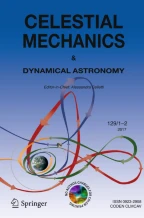Abstract
Analytical solutions for quasi-periodic orbits about the translunar libration point are obtained by using the method of Lindstedt-Poincaré and computerized algebraic manipulations. The solutions include the effects of nonlinearities, lunar orbital eccentricity, and the Sun's gravitational field. For a small-amplitude orbit, the orbital path as viewed from the Earth traces out a Lissajous figure. This is due to a small difference in the fundamental frequencies of the in-plane and out-of-plane oscillations. However, when the amplitude of the in-plane oscillation is greater than 32 379 km, there is a corresponding value of the out-of-plane amplitude that will produce a path where the fundamental frequencies are equal. This synchronized trajectory describes a ‘halo orbit’ of the Moon.
Similar content being viewed by others
References
Blaquière, A.: 1966,Nonlinear System Analysis, Academic Press, New York.
Farquhar, R. W.: 1970, ‘The Control and Use of Libration-Point Satellites’, NASA TR R-346.
Farquhar, R. W.: 1971, ‘The Utilization of Halo Orbits in Advanced Lunar Operations’, NASA TN D-6365.
Farquhar, R. W.: 1972,Astronaut. Aeronaut. 10, No. 6.
Farquhar, R. W. and Kamel, A. A.: ‘Satellite Stationkeeping in the Vicinity of the Translunar Libration Point’, (in preparation).
‘Final Report for Lunar Libration Point Flight Dynamics Study’, Contract NAS-5-11551, General Electric Co., April 1969.
Moulton, F. R.: 1914,An Introduction to Celestial Mechanics, Macmillan, New York.
Szebehely, V.: 1967,Theory of Orbits: The Restricted Problem of Three Bodies, Academic Press, New York.
Author information
Authors and Affiliations
Rights and permissions
About this article
Cite this article
Farquhar, R.W., Kamel, A.A. Quasi-periodic orbits about the translunar libration point. Celestial Mechanics 7, 458–473 (1973). https://doi.org/10.1007/BF01227511
Received:
Issue Date:
DOI: https://doi.org/10.1007/BF01227511
